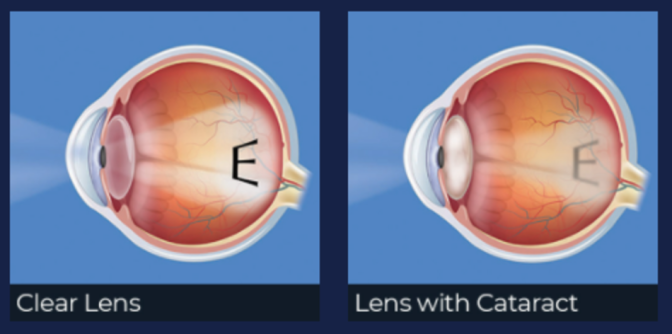Buy one pair of eyeglasses, get a second pair free!
*Restrictions apply. Click here for details.
Cataract Treatment in Arizona

What are Cataracts?
A cataract is a clouding of the eye's natural lens, which lies behind the iris and the pupil. Cataracts most commonly develop naturally as a part of the aging process. Although, they can also result from exposure to toxic substances, diseases such as diabetes, or physical injury.
Cataracts are the most common cause of vision loss in people over age 40 and is the principal cause of blindness in the world. In fact, according to Prevent Blindness America (PBA) there are more cases of cataracts worldwide than there are of glaucoma, macular degeneration and diabetic retinopathy combined. Today, cataracts affect more than 22 million Americans age 40 and older.
What Causes Cataracts?
The lens inside the eye works much like a camera lens, focusing light onto the retina for clear vision. It also adjusts the eye's focus, letting us see things clearly both up close and far away.
The lens is mostly made of water and protein. The protein is arranged in a precise way that keeps the lens clear and lets light pass through it. But as we age, some of the protein may clump together and start to cloud a small area of the lens. This is a cataract, and over time, it may grow larger and cloud more of the lens, making it harder to see.
Risk Factors of Cataracts
Besides advancing age, cataract risk factors include:
Ultraviolet radiation from sunlight and other sources
Diabetes
Hypertension
Obesity
Smoking
Prolonged use of corticosteroid medications
Statin medicines used to reduce cholesterol
Previous eye injury or inflammation
Previous eye surgery
Hormone replacement therapy
Significant alcohol consumption
High myopia
Family history

Cataract Symptoms and Signs
A cataract starts out small and at first has little effect on your vision. You may notice that your vision is blurred a little, like looking through a cloudy piece of glass or viewing an impressionist painting.
Hazy, blurred vision may mean you have a cataract. A cataract may make light from the sun or a lamp seem too bright or glaring. Or you may notice when you drive at night that the oncoming headlights cause more glare than before. Colors may not appear as bright as they once did.

Cataract Treatment in Arizona
Many people consider poor vision an inevitable fact of aging, but cataract surgery is a simple, relatively painless procedure to regain vision. Cataract surgery is very successful in restoring vision. The only way to diagnose if you have cataracts, as well as to determine the proper treatment, is to have a comprehensive eye examination. Fortunately, the Doctors of Nationwide Optometry often can correct your cataract-related vision problems with glasses or contacts. However, individuals with advanced cataracts may be advised to consider a cataract procedure.
The procedure involves removing the clouded lens from your eye and replacing it with a transparent intraocular lens (IOL). After the procedure, you can expect a drastic improvement in your vision. If you believe you are a candidate for the procedure, treatment is available at one of our medical centers.
Find a Nationwide Vision Eye Care Center Near You
The trusted team of highly trained Arizona eye doctors at Nationwide Vision focus on maintaining the health of your eyes. We offer comprehensive eye care services including routine eye exams, preventative care, and treatment of complex conditions.
